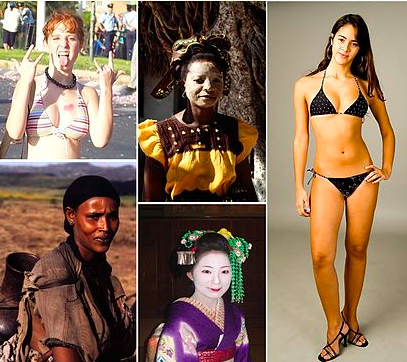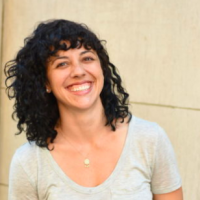The way we feel about our bodies is personal.
We form a relationship with our bodies and ourselves throughout our lives, and like every relationship, that relationship is unique, reflecting our long history together.
But the way we feel about our bodies is also reflective of a larger cultural dynamic in which some bodies are treated as superior or inferior to other bodies; a cultural dynamic in which some bodies are celebrated, and some are despised.
Here’s the thing—the reason you hate your body is different than the reason someone else is going to hate their body. Maybe you’re obsessed with your belly fat or the fact that your legs are “too big” while she’s obsessed with the ways in which her body betrayed her with fibromyalgia. One person might hate her body for looking so sexual that she got assaulted, and another might hate her body for not looking sexual enough to keep her husband interested.
When I work with a client, I help them identify the unique story underneath their feelings of negativity, hatred, resentment, betrayal, or anger toward their bodies, and it varies dramatically from person to person.
This is why most of the work I do is private and one-on-one: because each person needs to look below the surface of their own individual body stories, experiences, beliefs, fears, shames, and desires in order to suss out what needs healing, changing, uprooting, replacing, and accepting to make amends. There is no “one path” for everyone when it comes to body neutrality.
That said, there are patterns of conditioning internalized by all of us from the moment we’re born, about what kind of body is good and what kind of body is bad; about what the shape and size, age, gender, and presentation of someone’s body mean about a person’s moral character and value, and what they deserve in life. We are conditioned early to “know” what kind of body is worthy of visibility, respect, love, acceptance, and celebration…and what kind is worthy of marginalization, bullying, disrespect, violence, and erasure.
In short, we are conditioned early to believe that when a person looks a certain way, they deserve to be treated a certain way, and that therefore we can tell how a person deserves to be treated just by looking at them.
In the book I wrote (and benched due to limited bandwidth thanks to COVID-19), I start by describing the seven biggest social hierarchies we see in our culture which impact body image—seven areas in which we unconsciously learn that one kind of body is better and more worthy than another.
The seven areas are:
>> The hierarchy of weight and size
>> The hierarchy of race and ethnicity
>> The hierarchy of ability
>> The hierarchy of gender
>> The hierarchy of gender normativity/expression/performance
>> The hierarchy of age
>> The hierarchy of beauty and desirability
It’s worth noting here that I also could have put it this way:
>> Fatphobia and thin supremacy
>> Racism and white supremacy
>> Ableism
>> Sexism and misogyny
>> Homophobia and transphobia
>> Ageism
>> Lookism
Either way, those are the biggest social constructs that impact a person’s relationship with their own body; these areas of privilege and oppression play a huge role in how we are treated, what people believe/assume about us, and what kind of treatment and life we supposedly deserve.
Part of the work of moving toward body neutrality requires exploring and unpacking these social hierarchies inside yourself and releasing or dismantling them.
To begin this process, I recommend going through the above list and simply asking yourself who is at the top of that hierarchy, and who is at the bottom.
For example, very thin and lean/muscular people are obviously at the top of the first hierarchy, while very fat people are at the bottom. This is to say that very thin/lean people are more visible and seen as far more worthy of respect, happiness, success, love, celebration, intimacy, and belonging than very fat people. If that’s true, then we must also acknowledge that very fat people are less visible and seen as far less worthy of all of those things.
It’s no wonder so many people struggle with food, exercise, and their weight, given this social construct. We are all upholding a system of power and privilege, and of bias and oppression, based on body size. We’ve all been conditioned to believe that we can tell something about a person’s moral character, value, and worth based on their body size and to associate goodness or badness with body size.
The problem with all this conditioning is that even though it’s ubiquitous, it’s a f*cking lie.
Body size does not actually make a person more or less worthy of good things in life—nor does race, ability, gender, gender presentation, age, or how close a person is to conventional beauty ideals.
But I can’t convince anyone that being fat is just as beautiful and awesome as being thin, or that having a disability is just as great as not having a disability. I can’t convince anyone of anything, and I won’t try. As a body image coach, that’s not my job.
Instead, I’m here to help you dismantle the entire paradigm inside yourself that says any kind of body is more worthy than any other kind of body, that a person’s appearance means something about them, and that how a person deserves to be treated is based on how they look.
Once you dismantle that sh*t inside yourself—once you explore, unpack, and dismantle each individual hierarchy—body image enters a whole new ballpark.
The truth is that someone can only shame you for something you already feel shame about.
Once you dismantle the entire system that says some bodies are shameful, nobody can shame yours—and in fact, when they try, they’ll feel the full force of the discomfort they intended to pass off to you.
You can’t make us feel self-conscious about things that we have decided to own and embrace. You can’t make us feel bad about parts of our bodies we have detached from any negative meaning. It’s impossible to “feel ugly” when you no longer see being closer to conventional beauty ideals as better or important.
But it’s also important to note that your relationship to these hierarchies is more than just personal. If you are fat, Black, disabled, transgender, or elderly, you will be treated differently, and if you’re at the bottom of multiple hierarchies, you’re in the most danger. You will be erased, marginalized, and unsafe. You will be treated poorly, denied access and opportunities, and put in harm’s way over and over. You will struggle with the health consequences of constantly elevated stress, and be a target for everything from discrimination to assault and murder.
Improving body image is about far more than just changing your individual belief system about what these hierarchies mean, and any body image/body positivity coach or leader who says otherwise is contributing to social systems of violence and oppression.
If you want to be free of body image issues, you’ll need to look at body liberation, which includes doing the work required to explore all of these hierarchies in-depth, not just the ones that affect you. This means getting educated, increasing your exposure to, and listening to the experiences of the most marginalized folks at the bottom of each hierarchy, and fighting for them to be safe, centered, and equal.
This means learning about racism, ableism, ageism, fatphobia, sexism, intersectional feminism, and getting involved in the movements that fight for their safety and freedom.
This means committing yourself to not just trying to “feel better” about the way you look by just attempting to increase your status in any particular hierarchy (think: losing weight to avoid fatphobia), and instead, committing yourself to fighting the oppression facing the people at the bottom.
This work is actually about dismantling the entire scaffolding of social status; it’s about tearing down the entire paradigm within which these hierarchies exist inside yourself, and starting over.
Obviously this is a much bigger topic than I can tackle in one post (hence why I wrote a book, maybe someday I’ll actually get it published), but I recommend beginning by exploring the hierarchies I’ve listed above.
Try asking yourself these questions:
>> Who is at the very top and very bottom of each hierarchy, and who is in the middle?
>> Where are you on each hierarchy? Are you at the top, or the bottom, or somewhere in the middle?
>> What have you learned or internalized about people at the top and bottom of each hierarchy? What do you believe about who they are, what they deserve, their moral character, value to society, and worthiness for visibility, respect, belonging, love, and happiness based on their position on each hierarchy? Where did you learn that, and how true is it, really?
>> How has this hierarchy, your conditioning about what it means about a person, and your position on it, shaped your own personal identity, self-worth, and experience of being in your body?
>> How might someone at the very bottom of this hierarchy be impacted in terms of identity, self-worth, and body image? How about the very top? What can you learn from this?
>> Which of the hierarchies are easy for you to identify and understand, and which ones are murky, confusing, invisible, or just seem wrong to you? Why might that be?
This exploration is the beginning of body liberation work, but it’s just scraping the surface.
~
If you want to learn more, or do the work privately with me, you know where to find me.








Read 1 comment and reply